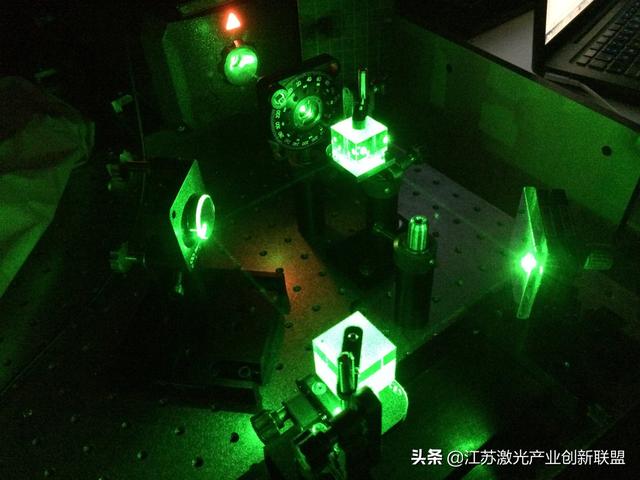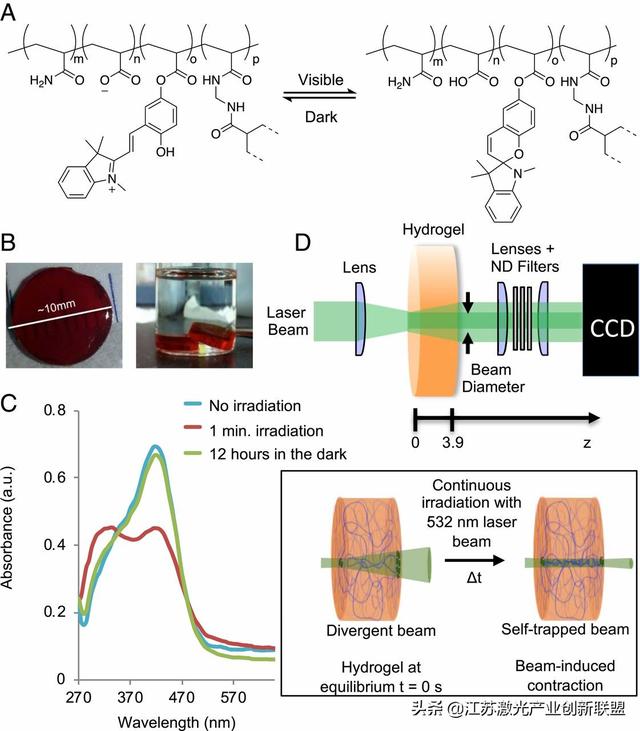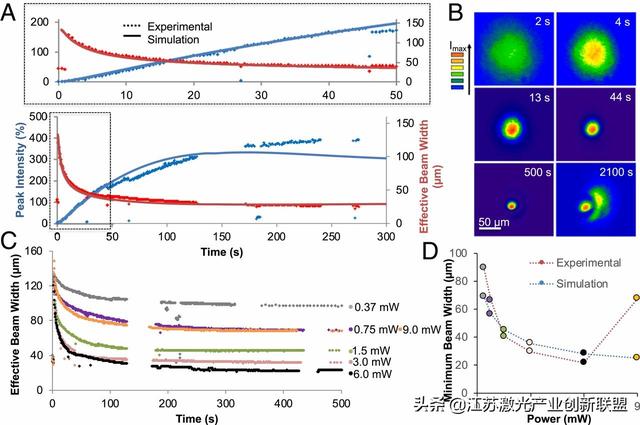近日,麦克马斯特大学和哈佛大学的研究人员合作开发一个新平台,可以让光束通过固体物质进行交流互动,这一研究为新型计算机形式研发奠定了基础。相关研究成果2月3日发表于美国《国家科学院院刊》。

A collaboration between McMaster and Harvard researchers has generated a new platform in which light beams communicate with one another through solid matter, establishing the foundation to explore a new form of computing. Credit: McMaster University
麦克马斯特大学副教授Kalaich elvi Saravanamuttu一直致力于对光有反应的材料化学的研究。他表示,这项技术是在他的实验室完成的,同时利用了哈佛大学研究团队的光操纵和测量技术,最终制造出了一种半透明的水凝胶。
这种半透明的材料外观上类似于树莓果冻,物质组成上加入了对光敏感的分子,这些分子的结构在有光的情况下会发生变化,赋予凝胶特殊性质,既能容纳光束,又能在光束之间传递信息。
一般来说,光束在传播时会变宽,但是凝胶能够沿着穿过材料的路径包含激光细丝,就像光通过管道一样。当多束激光束集中穿过同一种材料时,它们会影响彼此的强度,即便它们的光场完全没有重叠。这一事实证明这种凝胶是“智能的”。
Saravanamuttu解释说,这些光丝之间的相互作用可以被停止、启动、管理和读取,从而产生一种可预测的高速信息输出,这是一种有潜力发展成无电路计算形式的信息形式。
“虽然它们是分开的,但光束仍然能看到彼此,并因此而改变,”她说,“我们可以想象,从长远来看,这种智能响应可以计算操作。”
作为该论文的第一作者之一,Saravanamuttu实验室的研究生Derek Morim认为,虽然光计算这个更广泛的概念本身是一个独立发展的细分领域,但这项新技术引入了一个有前途的平台。
“我们不仅可以设计在光存在下可逆转换其光学、化学和物理性质的光响应材料,而且可以利用这些变化来创造光的通道,或自陷光束,以引导和操纵光,”他说,“进一步的研究可能让我们设计更复杂的材料,以实现用特定的方式操纵光和材料。”
哈佛大学约翰·保尔森工程与应用科学学院的研究生Amos Meeks认为,这项技术有助于推进全光计算的理念,即只用光束进行计算。
“目前大多数计算使用硬材料,如金属线、半导体和光电二极管,将电子与光耦合。”该研究的第一作者之一Meeks说,“所有光学计算背后的想法是移除那些刚性组件,用光来控制光。想象一下,一个柔软的、没有电路的机器人,是由太阳光驱动的。”
来源: 中国科学报 付嵘,原文来源:https://phys.org/news/2020-02-intelligent-interaction-material.html
视频加载中…

SP-modified hydrogels. (A) Photoisomerization scheme of chromophore substituents from the protonated merocyanine (MCH+, Left) to SP (Right) forms in the methylenebis(acrylamide) cross-linked p(AAm-co-AAc) hydrogel. (B) Photographs of chromophore-containing p(AAm-co-AAc) hydrogel monoliths employed in experiments. (C) UV-visible absorbance spectra demonstrating reversible isomerization of MCH+ (absorption λmax = 420 nm) to SP (λmax = 320 nm) in solution. (D) Experimental setup (Top) to probe laser self-trapping due to photoinduced local contraction of the hydrogel, schematically depicted on the Bottom (see also Movie S1). A laser beam is focused onto the entrance face of the hydrogel while its exit face is imaged onto a CCD camera.

Evolution of self-trapping in the SP-modified hydrogel; experiments and simulations. (A) Experimentally measured temporal evolution of peak intensity (blue) and effective width (red) of a laser beam (532 nm, 6.0 mW, with a width of 20 μm––corresponding peak intensity = 3.77 kW cm−2) acquired at the sample exit face; the beam is turned on at t = 0. Breaks in plots are time lapses between image logs. The experimental plots (dotted lines) are compared to numerical simulations (solid lines); the dashed black box above provides a zoomed-in view from 0 to 50 s, emphasizing the match between the experimental results and simulations. (B) Two-dimensional (2D) spatial intensity profiles experimentally acquired at select times. (C) Temporal evolution of beam width during self-trapping experiments at different optical powers. (D) Comparison of calculated and experimental values of minimum self-trapped beam width as a function of beam power.
原文翻译自:PNAS,RESEARCH ARTICLE,Opto-chemo-mechanical transduction in photoresponsive gels elicits switchable self-trapped beams with remote interactions
Derek R. Morim, View ORCID ProfileAmos Meeks, Ankita Shastri, Andy Tran, Anna V. Shneidman, Victor V. Yashin, Fariha Mahmood, Anna C. Balazs, Joanna Aizenberg, and View ORCID ProfileKalaichelvi Saravanamuttu,
PNAS first published February 6, 2020 https://doi.org/10.1073/pnas.1902872117